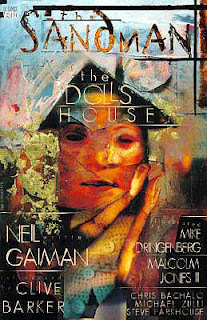(pb; 1989, 1990: graphic
novel, collects issues 8-16 of the comic book series The Sandman. Third
book in the thirteen-book Sandman graphic novel series.)
Overall review
Doll’s House
continues to mine the rich vein of genre fiction-fused-with-literary gold of the
second Sandman volume, Preludes and Nocturnes. This time out, it’s
Gaiman, Mike Dringenberg, Malcolm Jones III, Robbie Busch, Chris Bachalo, Michael
Zulli, Steve Parkhouse and Dave Kean delivering the heady, less-melancholy-than-Preludes goods, with a storyline about missing entities, nightmare-led “Cereal Growers”
and an unwitting, good-natured vortex.
Worth owning, this. Followed
by The Sandman: Dream Country.
Review, issue by issue
Caveat: possible, vaguely
stated spoilers for those who haven’t read Preludes
and Nocturnes (Vol. 2).
“The Sound of Her Wings”
(issue 8): Death, a petite, Goth-pale woman, visits her fellow godling brother
(Morpheus) who’s sitting in a Parisian park, feeding pigeons. (This issue is
also included in the previous Sandman graphic novel, Preludes and Nocturnes.)
“Tales in the Sand”
(issue 9): During a male coming-of-age ritual, an elder tribesman tells a
younger one about a long-ago queen (Nada) who becomes the lover of the Dream
Lord, Kai’Ckul─also called Morpheus─and the tragic results of that forbidden
love.
“The Doll’s House”
(issue 10): Desire and Despair─younger siblings of Dream, Death and Destiny─speak
about Nada and Morpheus. Elsewhere, Miranda Walker and her twenty-one-year-old
daughter (Rose) arrive in England after a mysterious benefactor (Unity Kinkaid,
an impregnated coma victim in Preludes and Nocturnes) pays for them to
be flown over from the US. Lucien, in the Dreamworld, tells Dream (a.k.a. Morpheus)
of four missing Major Arcana entities, among them the deeply unsettling
Corinthian, a nightmare who births serial killers.
“Moving In” (issue 11):
Rose Walker flies to Florida to find her missing twelve-year-old brother (Jed),
whom she hasn’t seen in seven years. What she doesn’t know is he’s chained to a
pipe in a wet, dark basement. Meanwhile, Matthew─a deceased
mortal-turned-blackbird in Morpheus’s direct service─watches Rose for the Dream
King: it seems Rose is a “vortex,” bound to trouble the dreams of those around
her, and to draw the attentions of the four missing Major Arcana entities,
particularly Glob, Brute, and Fiddler’s Green. The Corinthian continues his
sleazy motel killings.
“Playing House” (issue
12): Hippolyta Hall, pregnant and sharing dream-space with her husband (Harold)
and his strange associates, Glob and Brute, faces a harsh reality. Rose Walker
and her quirky, middle-aged housemate (Gilbert) head to the state of Georgia to
retrieve Jed, who’s escaped his abusive legal guardians (Clarice and her
husband, Barnaby). Unfortunately for Jed, he’s just made the acquaintance of
someone more sadistic.
“Men of Good Fortune”
(issue 13): 1389, England. Morpheus befriends a man (Hob Gadling) whose pub
opinion leads him to being granted eternal life─for as long as he wants it.
“Collectors” (issue
14): After their car breaks down, Rose Walker and Gilbert─who shows that he’s
more than seems─find themselves holed up in a sleazy motel where a “Cereal
Growers” (serial killers) convention is taking place. The unexpected guest of
honor? The Corninthian, who may’ve brought Jed along with him.
“Into the Night” (issue
15): Rose Walker, still a vortex, returns to the Florida boarding house,
further troubling the dreams of her housemates (Hal, “Spider Women” Chantal and
Zelda, and Ken and Barbie─Gilbert disappeared after the dissolution of the Cereal
Growers convention). Morpheus pulls Rose into the Dreamworld, saving her housemates.
Gilbert and Matthew the blackbird talk.
“Lost Hearts” (issue
16): Morpheus reveals to Rose her anomalous nature and unintended effect as
well as her fate. Gilbert, one of the missing entities, returns to Morpheus. In
England, Unity Kinkaid dies of old age, altering what is to happen.
Six months pass. Rose writes
in her journal, mentions her friend, Judy, who died a year prior─Judy was one
of the diner customers shown in “24 Hours” (issue 6, collected in Preludes
and Nocturnes). Morpheus visits Desire, confronts her/him/they about the impetuous
godling’s previously secret act of treachery, connected to Unity Kinkaid’s coma
pregnancy (in Preludes and Nocturnes).









